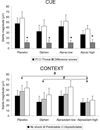Models and mechanisms of anxiety: evidence from startle studies
- PMID: 18058089
- PMCID: PMC2711770
- DOI: 10.1007/s00213-007-1019-1
Models and mechanisms of anxiety: evidence from startle studies
Abstract
Rationale: Preclinical data indicates that threat stimuli elicit two classes of defensive behaviors, those that are associated with imminent danger and are characterized by flight or fight (fear), and those that are associated with temporally uncertain danger and are characterized by sustained apprehension and hypervigilance (anxiety).
Objective: The objectives of the study are to (1) review evidence for a distinction between fear and anxiety in animal and human experimental models using the startle reflex as an operational measure of aversive states, (2) describe experimental models of anxiety, as opposed to fear, in humans, (3) examine the relevance of these models to clinical anxiety.
Results: The distinction between phasic fear to imminent threat and sustained anxiety to temporally uncertain danger is suggested by psychopharmacological and behavioral evidence from ethological studies and can be traced back to distinct neuroanatomical systems, the amygdala and the bed nucleus of the stria terminalis. Experimental models of anxiety, not fear, are relevant to non-phobic anxiety disorders.
Conclusions: Progress in our understanding of normal and abnormal anxiety is critically dependent on our ability to model sustained aversive states to temporally uncertain threat.
Figures






References
-
- Adamec RE, McKay D. Amygdala kindling, anxiety, and corticotrophin releasing factor (CRF) Physiology & behavior. 1993;54:423–431. - PubMed
-
- Alheid GF, Beltramino CA, De Olmos JS, Forbes MS, Swanson DJ, Heimer L. The neuronal organization of the supracapsular part of the stria terminalis in the rat: the dorsal component of the extended amygdala. Neuroscience. 1998;84:967–996. - PubMed
-
- Allen LS, Gorski RA. Sex difference in the bed nucleus of the stria terminalis of the human brain. J Comp Neurol. 1990;302:697–706. - PubMed
-
- Alpers GW, Abelson JL, Wilhelm FH, Roth WT. Salivary cortisol response during exposure treatment in driving phobics. Psychosom Med. 2003;65:679–687. - PubMed
Publication types
MeSH terms
Substances
Grants and funding
LinkOut - more resources
Full Text Sources
Medical

